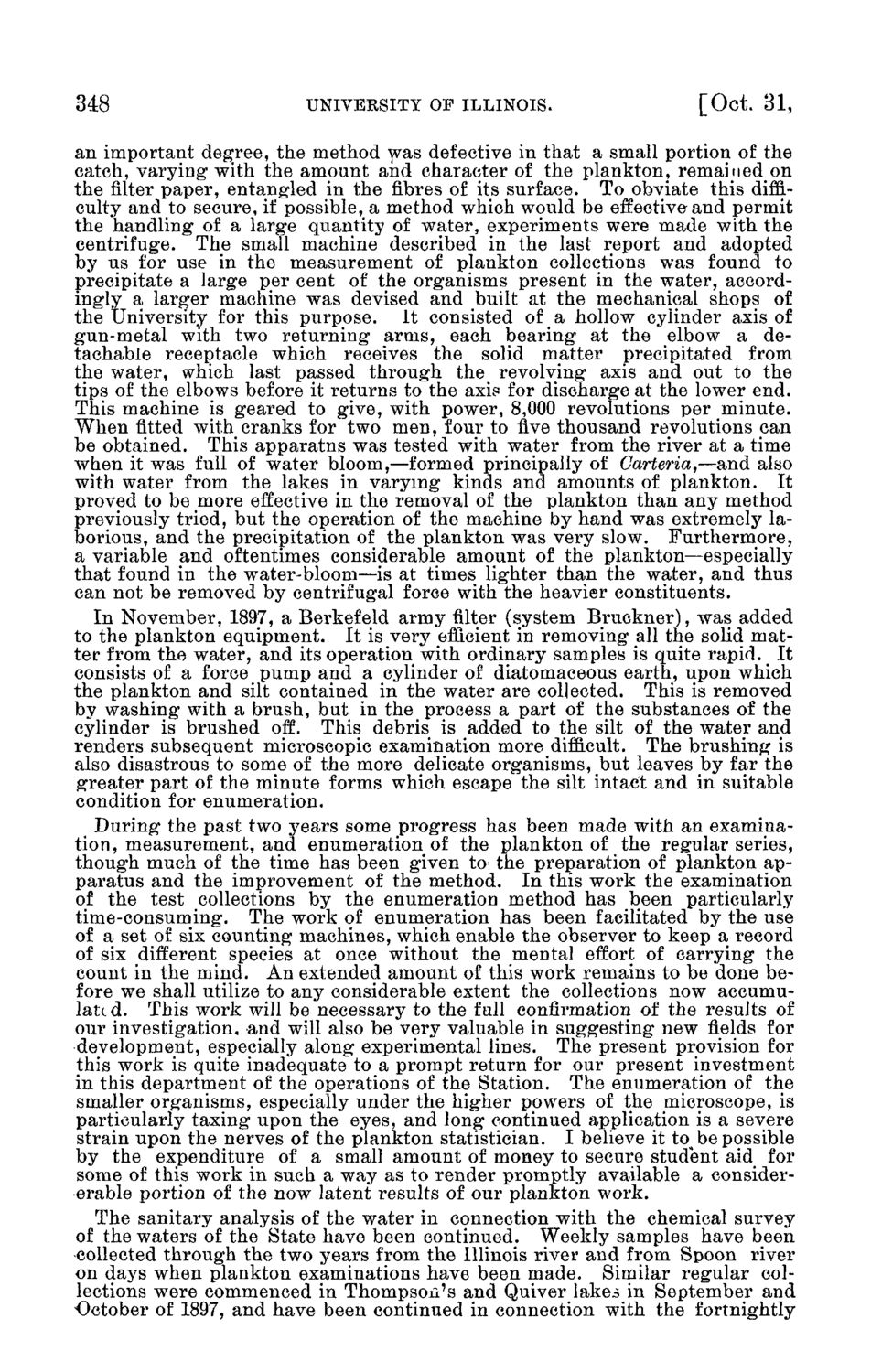| |
| |
Caption: Board of Trustees Minutes - 1898
This is a reduced-resolution page image for fast online browsing.

EXTRACTED TEXT FROM PAGE:
348 UNIVERSITY OF ILLINOIS. [Oct. 31, an important degree, the method was defective in that a small portion of the catch, varying- with the amount and character of the plankton, remained on the filter paper, entangled in the fibres of its surface. To obviate this difficulty and to secure, if possible, a method which would be effective and permit the handling of a large quantity of water, experiments were made with the centrifuge. The small machine described in the last report and adopted by us for use in the measurement of plankton collections was found to precipitate a large per cent of the organisms present in the water, accordingly a larger machine was devised and built at the mechanical shops of the University for this purpose. It consisted of a hollow cylinder axis of gun-metal with two returning arms, each bearing at the elbow a detachable receptacle which receives the solid matter precipitated from the water, which last passed through the revolving axis and out to the tips of the elbows before it returns to the axis for discharge at the lower end. This machine is geared to give, with power, 8,000 revolutions per minute. When fitted with cranks for two men, four to five thousand revolutions can be obtained. This apparatns was tested with water from the river at a time when it was full of water bloom,—formed principally of Carteria,—and also with water from the lakes in varying kinds and amounts of plankton. It proved to be more effective in the removal of the plankton than any method previously tried, but the operation of the machine by hand was extremely laborious, and the precipitation of the plankton was very slow. Furthermore, a variable and oftentimes considerable amount of the plankton—especially that found in the water-bloom—is at times lighter than the water, and thus can not be removed by centrifugal force with the heavier constituents. In November, 1897, a Berkefeld army filter (system Bruckner), was added to the plankton equipment. It is very efficient in removing all the solid matter from the water, and its operation with ordinary samples is quite rapid. It consists of a force pump and a cylinder of diatomaceous earth, upon which the plankton and silt contained in the water are collected. This is removed by washing with a brush, but in the process a part of the substances of the cylinder is brushed off. This debris is added to the silt of the water and renders subsequent microscopic examination more difficult. The brushing is also disastrous to some of the more delicate organisms, but leaves by far the greater part of the minute forms which escape the silt intact and in suitable condition for enumeration. During the past two years some progress has been made with an examination, measurement, and enumeration of the plankton of the regular series, though much of the time has been given to the preparation of plankton apparatus and the improvement of the method. In this work the examination of the test collections by the enumeration method has been particularly time-consuming. The work of enumeration has been facilitated by the use of a set of six counting machines, which enable the observer to keep a record of six different species at once without the mental effort of carrying the count in the mind. An extended amount of this work remains to be done before we shall utilize to any considerable extent the collections now accumulate d. This work will be necessary to the full confirmation of the results of our investigation, and will also be very valuable in suggesting new fields for development, especially along experimental lines. The present provision for this work is quite inadequate to a prompt return for our present investment in this department of the operations of the Station. The enumeration of the smaller organisms, especially under the higher powers of the microscope, is particularly taxing upon the eyes, and long continued application is a severe strain upon the nerves of the plankton statistician. I believe it to be possible by the expenditure of a small amount of money to secure student aid for some of this work in such a way as to render promptly available a considererable portion of the now latent results of our plankton work. The sanitary analysis of the water in connection with the chemical survey of the waters of the State have been continued. Weekly samples have been collected through the two years from the Illinois river and from Spoon river on days when plankton examinations have been made. Similar regular collections were commenced in Thompson's and Quiver lakes in September and October of 1897, and have been continued in connection with the fortnightly
| |